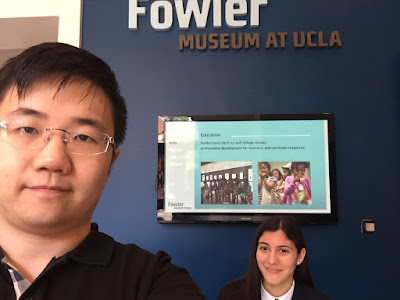Event #3 Reflecting Culture: The Francis E. Fowler, Jr. Collection of Silver
At the Fowler Museum, I was attracted by this silver collection exhibition with beautiful green wall as background. The exhibition is a collection of silver by Francis E. Fowler, Jr. It includes silver garments and products from 16th to 19th century, from United States to Europe. All the silver collections inside the exhibition was beautiful and stunning, well kept and was created by well known workshops at that time.
There were all things made of silver: from cups to bowls, from ship with wheels to goblets and bowls. And it is a recent history of human usage on silver, a precious and beautiful material.
This made me think that from far old times in oriental palaces and royal courts, there were chopsticks made of silver. Servants of the royal family would use these silver chopsticks to taste each and every dish before the royal family can have their meal. This was to make sure that the dishes were not poisoned because silver would become black color if it make contact with certain kind of poisons.
Nowadays, there are more extensive use of silver. Some of the applications of silver happens at the nanotechnology level. And silver was one of the first materials that are being studied and used at the nanotechnology level.
From oriental palaces in hundreds of years ago to beautiful garments and products made in Europe a few centuries ago, human beings created beautiful artworks with silver, but have only utilized this precious material at a level can be seen by our eyes.
However, nanotechnology today have made usage of silver at a whole new level even cannot be seen by human eyes and normal microscopes. Human being have been creating stunning artworks for tens of centuries and now we are creating artworks at a scale we cannot see, using nanotechnology.
The exhibition of Reflecting Culture of collection of silver products from old times made me think of the art we are creating today.
In the past days, we utilized silver at a level can be seen and created beautiful artworks and now we are utilizing it at a level we cannot see.
Nowadays, nano silver particles are being used as antiseptic material coated on products we use every day, and nano silver particles are being used as high efficiency catalyst in chemical and industrial production. The nanoparticle of silver is proved to have effective antiseptic properties. In medical aspect, nano particles have been used to enhance the healing of wounds, shorten the process and improve the look of the wound cosmetically. This also relates to the medical technology and art topic we introduced in week 4.
It is artistic minds and advance in nanotechnology together made these applications available at the nanotechnology level. I believe the fact that our nanotechnology application of silver is benefiting human beings at a level cannot be seen by us is a form of art.
I would highly recommend this event to my classmates because it provokes thinking of a material and art and technology at a perspective that crosses history. I also believe that a exhibition combining silver artworks from the past and contemporary artworks and applications with silver and nanotechnology with a historical perspective would stunning and fascinating!

Me at the Reflecting Culture Exhibition

Me with Fowler Museum Reception Staff
* I asked every staff in the exhibition to take a photo with me, but they said they had issues with this photo-taking before and only the staff at the reception can do that, so I took pictures of myself at different events and a photo of me and the reception staff.
Citations:
1 Deardroff, Julie. "Some Antibacterials Come with Worrisome Silver Lining." Chicago Turbine, 16 Feb. 2014. Web. 7 June 2015. <http%3A%2F%2Farticles.chicagotribune.com%2F2014-02-16%2Fhealth%2Fct-nanosilver-met-20140216_1_consumer-products-other-antibiotic-drugs-germs>. 2 Fowler, Francis E., Jr. Reflecting Culture: The Francis E. Fowler, Jr. Collection of Silver. 6 June 2015. Fowler Museum, UCLA, Los Angeles.
3 "Silver in Nanotechnology." Silver Institute. N.p., n.d. Web. <https%3A%2F%2Fwww.silverinstitute.org%2Fsite%2Fsilver-in-technology%2Fsilver-in-nanotechnology%2F>.































